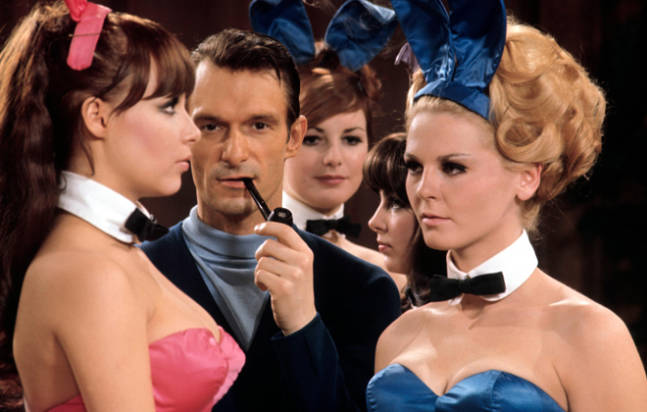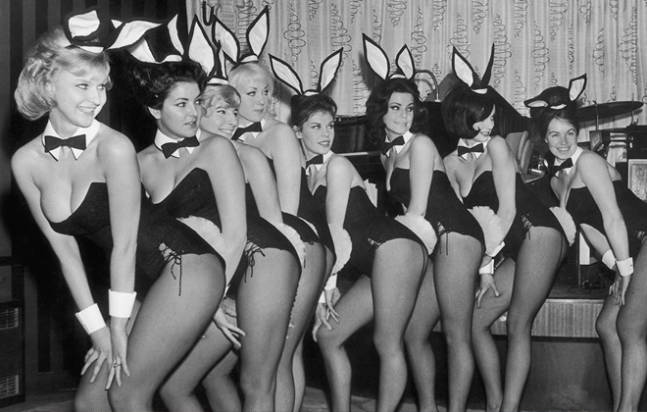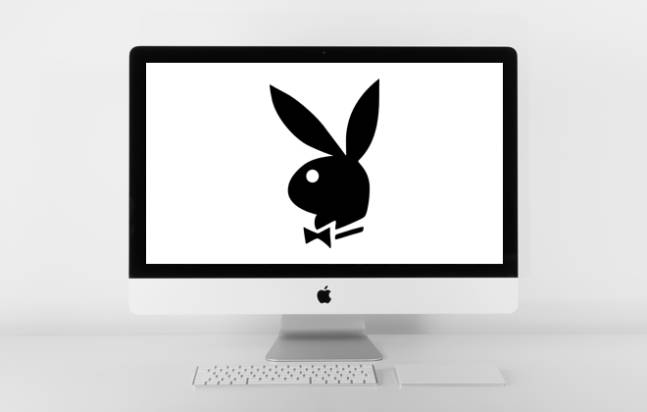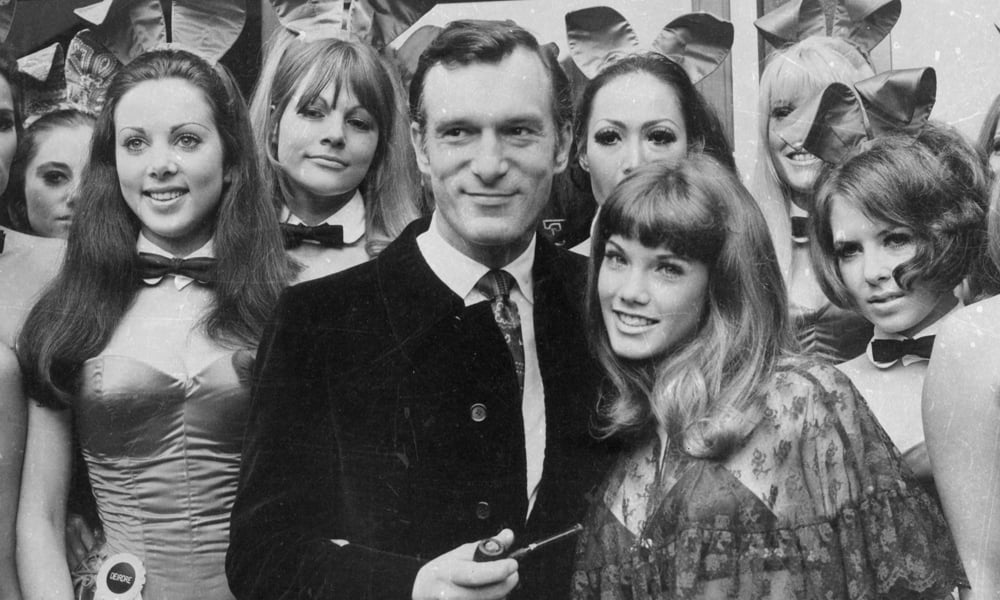A lot of the judgments you’ll hear about the cultural value and effects of Playboy will come from modern commentators espousing modern views for a modern audience. In that context, Playboy is easily and frequently dismissed as a rag that panders to the male gaze and contributes to the objectification of women.
These are fair criticisms. It’s certainly not a good look when your main product is flying off the shelves because it has naked women in it. And when the “I buy it for the articles” defense is literally paper thin. Not to mention, Playboy as a product was created by men and for men. The rules imposed on Playmates and Bunnies are also well documented, with curfews and limits on social lives and bodily proportions. Gloria Steinem, the internationally renowned feminist and writer, went undercover at the New York Playboy Club in 1963. Her expose revealed rampant sexism, harassment, and labor abuses.
But these criticisms demand context. Playboy’s first issue came out in the early 1950s, a time of absolutely asphyxiating sexual repression. In that BBC article we linked above, Dr. Thekla Morgenroth (a Hefner detractor in her own right) described the 1950s as a time when women could choose to be a “chaste virgin or a caring mother”, not exactly the most fulfilling dichotomy. For their part, men were expected to be stoic family men and productive workers, effectively erasing their time as a bachelor or their interests outside of family.
Any deviating sexual preferences were deemed mental illnesses at best and crimes against the Christian God at worst. It was lucky if you were only ostracized and unsettlingly common if you were beaten or murdered. The intolerance stretched to such absurd lengths the 1950 release of “I Saw Mommy Kissing Santa Claus” sent ministers railing against the degradation of American society.

The Man Behind the Magazines: Hugh Hefner
We should center Hugh Hefner in this context of sexual repression and aseptic unfulfillment. He was born April 9, 1926 in Chicago. He himself called his parents “Midwestern Puritans”, though to be accurate they were Methodists. He did well in school, though was bored more than anything else, and only started to come alive when he founded the newspaper for his alma mater, Steinmetz High School. Like everyone else his age, he served in the Army during the Second World War, then came home to study at the Chicago Art Institute and University of Illinois at Urbana-Champaign as a psych major. Fittingly, he also studied sociology, specifically Alfred Kinsey’s sex research institute. Finally, like the good boy he was supposed to be, he got a corporate job at Esquire as a copywriter. Throughout all of it, he identified the American lifestyle as packed to bursting with “hurtful and hypocritical” behavior.
Playboy Magazine Kicks Off
Playboy was Hefner’s attempt to rectify the damage that was being done to virtually anyone who dared question whether or not sex was something that could be possibly, maybe, just-on-the-off-chance something that is a little bit fun and healthy. And whether or not there were more exciting ways to spend your life than having two-and-a-half kids, living in the expanding suburbs, and getting ground down in a corporate job.
But Hefner didn’t start it out of the goodness of his heart or because of an overwhelming entrepreneurial spirit. He did it because he was out of a job. Esquire had denied him a raise, so he quit.
The first issue was published from his house in Chicago’s South Side using $8,000 he’d scraped together from investors, including his mother and brother, and had Marilyn Monroe’s famous visage on the cover and as the first “Sweetheart of the Month” (Playmate would be coined in the next issue and used for all subsequent models). It was released in December 1953, but without a date given Hefner’s uncertainty as to whether or not there’d be a second issue.
Interesting to note, Monroe never actually posed for Playboy magazine’s first issue. Hefner did the equivalent of buying and printing stock photos. In 1949, Monroe was short on cash and agreed to pose for Tom Kelley for the queenly sum of 50 bucks. Her career took off in 1950 with two big movies. Meanwhile, Kelley sold the photos to Western Lithograph Company, which is where Hefner bought them for $500. Her inclusion is undeniably one of the reasons the first issue sold more than 50,000 copies. And even though Hefner didn’t work with her directly, the two eventually became close friends.

The Rise and Golden Years of Playboy Magazine
It should be emphasized that expanding lifestyle options for everyone was always at the root of Playboy, sexuality was just part of how Hefner got people to pick up a copy. Hefner used the magazine to sneak a wide array of interests he thought the modern man should be following. In the first issue, Hefner included an introduction to the magazine that listed four ideal conversation topics for the modern man and his female acquaintance. They were, “Picasso, Nietzsche, jazz, [and] sex.” You’ll notice that sex comes last.
Hefner dumped the profits from the first issue back into the magazine and began a steady expansion. Circulation rose steadily through the 1950s and 60s, partially because there was so little competition and partially because its content, beyond the nudity, was really that good.
For decades, Playboy was at the cutting edge of fiction, music, fashion, and human rights. Its fiction alone puts it in a league with The Atlantic, The New Yorker, The Paris Review, and any other literary outlet that talks about their pedigree of major writers. Ray Bradbury was a regular, publishing short fiction and excerpts of Fahrenheit 451. Roald Dahl had plenty of work beyond his children’s stories and Joyce Carol Oates was a contributor to and defender of Playboy Magazine. James Baldwin published a civil rights essay and Margaret Atwood had multiple stories printed. These are not smutty slouches. These are genre-defining, barrier-smashing authors.
If you want another list of impressive names, Playboy routinely interviewed civil rights leaders, counting Martin Luther King, Jr., Malcolm X, and Muhammed Ali among its subjects. But it wasn’t limited to interviews. In 1959, Hefner booked the Chicago Stadium for the Playboy Jazz Festival with performances by Miles Davis and Ella Fitzgerald, two of the names that give jazz its persistent influence. Then, as if a massive jazz festival wasn’t enough, the first Playboy Club opened in Chicago 1960 without any inkling that segregation was an option. Black and white performers and patrons were brought in through the front door. The modern man should have no time or patience for archaic views on race relations.
To try and elevate the sexuality of Playboy to the same level as its fiction, journalism, and activism, we should address its approach to nudity. Where Hefner’s competing publications featured unattainable models posed in a vacuum, Playmates were sexually desirable women you could meet in everyday life. They were suggestively posed, for sure, but the idea was for the pictures to be snapshots of their larger lives as women. In Hefner’s words, they’d be “the new secretary at your office” or “the girl who sells you shirts and ties.” Whether or not he succeeded is a worthwhile debate, but the intention was to emphasize the healthier aspects of human sexuality, not to degrade women as objects whose usefulness was limited to gratification.
That held up in letters to the editor as well. Playboy’s responses to readers frequently stressed that relationships required respect and fidelity. Women were also told that their sexual fulfillment was as important as their partner’s, putting Playboy’s actual advice in stark opposition to its reputation.
The Playboy Clubs also had their heyday in the 60s. We mentioned the Chicago location already, the first to open in 1960, but the decade saw dozens of locations popping up across the country. Miami, New York, Baltimore, Kansas City, Los Angeles, Boston, and Denver all had their own clubs, and that’s only to name a few. Clubs continued to open throughout the 70s and 80s. There were also international Playboy businesses in Jamaica, Japan, and the Philippines, again, only to name a few.
The Fall of Playboy Magazines
Playboy had made such a name for itself that even the launch of its first major competitor, Penthouse in 1969, wouldn’t majorly impact circulation. At its peak in the 1970s, Playboy Magazine was selling around 5.6 million copies an issue, with November 1972 seeing 7.2 million sales.
The real decline didn’t start until the 1980s and would continue to today. Penthouse was finally around long enough to start siphoning off readers, an effect exacerbated by the addition of Hustler to the mix in 1974. Both magazines were more explicit, which meant the men who were buying for boobs had a publication catering to their more base interests. Video porn also took off in the 1980s, to similar effect as Penthouse and Hustler. Even then, Playboy Magazine fell to a respectable 3.4 million subscribers and maintained its position as an outlet for progressive politics.
The 1980s also saw the closure of every single Playboy Club. By 1986, none existed. It’s likely that they were a victim of their own success. Throughout the 60s and 70s, the clubs and Playboy magazines were major forces in the ongoing sexual revolution. Men were no longer expected to skip their bachelor period and women had far more agency in their relationships. But this also meant that the clubs didn’t serve the same purpose as they used to. Perception had shifted. Instead of fighting against gender norms and advocating for desegregation, they’d become archaic institutions where female employees were degraded and men leered.
The 90s weren’t kind either. More competitors hit the market, including FHM Magazine in 1985, Maxim in 1995, and Stuff in the US in 1999. Then in 1999, the internet first showed its potential. Playboy magazines would be slow to move to online content, which would cost it valuable time and readership. They tried suing internet browsers for showing Playboy competitors in searches that were specifically for Playboy. Litigation obviously seemed like a good idea at the time, and it’s not entirely insane to think it might have helped if things had worked out differently. But the current state of search results and online advertising would suggest Playboy didn’t get what they wanted.
We should also say, Christie Hefner, Hugh Hefner’s daughter, took over the major operations of the Playboy brand in 1988, while her father stayed on the magazine as editor in chief. It’d be easy to blame her for the brand’s decline, but that wouldn’t be fair. She was dealt a tough hand and did her best to diversify. She was the one who stanched the bleeding circulation, reinforced Playboy’s stance on politics and equality, and oversaw the surprisingly strong merchandise sales. Her leadership also saw the expansion of women’s roles in Playboy, no mean feat for a fundamentally male brand.
The major decline happened in the 2000s, when free online pornography forced a reckoning. There were scattered attempts to stay relevant, some of which were good ideas. An online presence finally launched in 2004 in a better-late-than-never shot, Hefner’s six-season reality TV run starting in 2005, the re-privatization of the brand in a $207 million deal in March 2011, and the posting of the online archives in May 2011.

The Changing Times: What the Future Holds for Playboy Magazine
Cooper Hefner, Hugh’s son, took over as Chief Creative Officer in 2016. His time has mostly focused on figuring out how to best update the brand, especially after his father’s death in 2017. He’s active on social media and has made a few moves that worked and some that didn’t. There was the removal of nudity in 2016, a move that was respectable but ultimately reversed in 2017 when Cooper determined nudity wasn’t the reason for the decline. He also oversaw the inclusion of the first transgender Playmate, Ines Rau, in 2017, yet another time Playboy used its weight to influence an ongoing human rights issue.
In spite of all this, circulation fell to roughly 210,000 in 2018 and completely stopped print publication in spring 2020, a victim of the larger decline of print and traditional media. There are ongoing attempts to update the brand, including what could be the promising launch of CENTERFOLD, a sort of Playboy branded OnlyFans. It’s way too early to tell what the effect will be, but it’s not crazy to think it could work.
If there’s a fundamental problem, though, it seems to be this. The prevalence and ease of access to online pornography means we’re more exposed to sex than the people of 1953 were. In that sense, Playboy Magazine accomplished its goal. But used a classic double-edged sword to do it. The rise of consumption of violent and demeaning content means we’ve leaned heavily into the objectification that (the admittedly rose-colored view of) Playboy sought to avoid. If Playboy was about reshaping the modern man into someone who appreciates the fullness of life, sex included, it’s possible we’ve overcorrected to become a society where sex is an objective to achieve by using other people’s bodies. Where Hefner wanted to incorporate a healthy fulfilling sex life into the larger aspects of the modern man, we’ve completely separated sex, music, politics, and literature. The modern stripping of context prohibits us from thinking about Picasso, Nietzsche, jazz, and sex at the same time.
If that is the case, Playboy may be due for another society-shaping moment. They’re fully digital now, which means the brand is going to be forced to contend with an internet that hates contextualization more than anything else. But contextualization is what Playboy did best at its peak and if the brand could get Midwestern Puritan society to rethink “I Saw Mommy Kissing Santa Claus”, it might be able to get the internet to work on its critical thinking.




